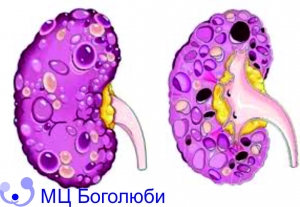Multicystic kidney – disease is a genetically determined disease characterized by the appearance of numerous cysts in both kidneys. These cysts are sacs lined with epithelium and contain fluid. With polycystosis, the weight and size of the organ increases three or four times compared to the normal size.
Kidney cysts can have a different size: from a few millimeters to 4-5 centimeters. They penetrate into the field of glomerular filtration, this explains their filling with liquid, in particular, urine.
Classification
Polycystic can be of two forms: autosomal dominant and autosomal recessive. The first form is present from birth, but the symptoms of the disease begin to appear from 30 to 40 years. With an autosomal recessive form, the child often dies after childbirth or during the first year of life. Cysts in a baby appear still in utero.
Causes of multicystic kidney
disease Multicystic kidney disease causes a genetic mutation in which numerous cellular changes occur when calcium enters the cell. The renal tubules do not function properly, the calcium signal changes, and all this leads to the formation of cysts.
Symptoms and complications
As mentioned above, the dominant form of the disease does not make itself felt until adulthood. The recessive form has a quick and fatal course. The various stages of the disease are characterized by the following symptoms: first there are pains in the abdomen and lower back, the stomach swells; then there is blood in the urine, bilateral renal colculi, urinary tract infections often occur.
Lower back pain is caused by an increase in kidney volume and compression of the surrounding anatomical regions. In some cases, a blockage of the ureter is possible, then an acute attack of renal colic occurs.
The most serious complications of polycystic kidney disease are: chronic renal failure, chronic hypertension, cerebral aneurysm, diverticular disease of the colon. Pregnant women with polycystic can develop preeclampsia.
Diagnosis
Awareness of the patient's family history is useful for early diagnosis of the disease, even in the absence of obvious symptoms.
For a complete and safe diagnosis, ultrasound of the kidneys and MRI can be performed, which will show an increase in organ volume and the presence of fluid-filled cysts. The presence of blood and protein in the urine is a characteristic sign of a polycystic kidney.
Therapy
To date, there are no special treatment methods that would stop the formation and growth of cysts. If the formations are small and there is no tendency to growth, the outflow of urine and blood supply to the organ are not disturbed, then the patient should do an ultrasound regularly to monitor the situation.
Cyst resection is indicated for:
- large sizes;
- inflammatory process;
- suppurations and abscesses;
- high risk of rupture and development of peritonitis;
- suspected malignant nature.
Surgeons of Bogoliuby MC successfully practice laparoscopic resection of renal cysts. This is a gentle, minimally invasive intervention, the safest and most effective.
Before the onset of symptoms, the patient does not need treatment. However, it is recommended that an ultrasound scan of the kidney be performed at least once a year. Contact sports such as boxing or rugby should be ruled out, as there is a significant risk of cyst destruction and bleeding.

















